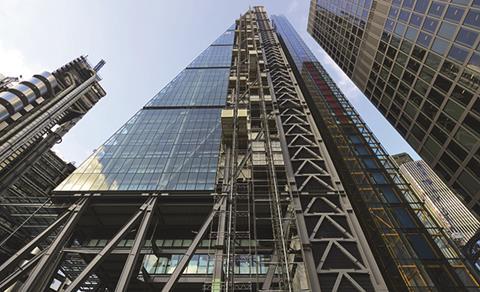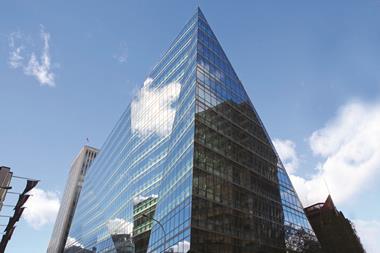The property industry must embrace new tech to ensure the UK remains an attractive place to do business.

Nothing has changed the way we live and work as much as the internet. Businesses depend on the ability to communicate and share data with colleagues and clients across the world, and even the US presidential election was won and lost on the back of social media.
With this in mind, a wireless connection has become as much of a vital utility as water, electricity or gas.
However, analysis from Ofcom suggests that 4.5 million people in the UK workforce are affected by poor connectivity.
So why is it that, when bringing forward new office buildings, connectivity is often at the bottom of developers’ to-do lists?
There is currently around 8.2m sq ft of office space in the City of London that is due to be completed by 2019, and most of the developers won’t consider their wireless connection until the occupiers are almost ready to move in.
But the process is much easier when wireless networks are built into the fabric of new buildings, rather than being added on as an afterthought.
‘Plug and play’
When landlords engage with telecommunications providers at an early appraisal or design stage, they can ensure they have the best possible levels of connectivity as well as making life easier for occupiers who will be able to simply ‘plug and play’.
On the other hand, if they are installed post build, this could cause disruption for tenants, and landlords will have to retrofit the damage. This is an issue that will only become more pressing as time goes on.
Business is evolving so rapidly, and the speed with which we transfer data is only going to get faster in the years to come.
Over the next five years, the property industry needs to make sure it is ready to accommodate this generation when they join the workforce in the early 2020s.
By that time, the growth of flexible and remote working will mean that connectivity will be integral to the way people do their jobs, but it will also form an important part of looking after staff welfare.

The line between work and leisure time is becoming increasingly blurred - and just as landlords are beginning to build in spaces within offices where staff can socialise or take a break, they will also need to provide the technological infrastructure to match.
In this new world where people are relaxing at work and working at home, the ability to stream a video or make a Skype call seamlessly in the office will be key.
But it is not just about staff: good connectivity also has significant business benefits. Mobile usage data can be tracked and then aggregated to give companies an insight into how staff are using different parts of the building and at what times - information that they can then use to maximise the efficiency of their space.
Learning from leisure
One area that commercial landlords could learn from is the leisure sector. My team helped to roll out the mobile infrastructure for the Olympics on behalf of Locog: essentially getting London ready to host the globe.
A more co-ordinated approach to really push forward top-notch connectivity could go far in terms of bolstering the reputation of UK plc in the eyes of office occupiers
We are now working with venues such as concert arenas and football stadiums to make sure they are well provisioned from a technology perspective, so that the crowd can connect with what is happening.
There are now services such as Facebook Live where people can comment and stream on the go, and people are streaming one football game while they are physically at another - and these venues recognise that they need to be set up to support that.
Now, the business community has to follow in their footsteps. At the moment, commercial property is not aligned with lifestyles in terms of its technology.
Retail landlords are becoming more clued-up and are beginning to provide mobile connectivity in mobile devices in shopping centres, because they recognise that people now have facilities such as Apple Pay, which you can’t use without data. As a population, we have a huge demand and hunger for mobile data.
On a micro level, it is clear that good connectivity can improve a company’s day-to-day operations. But a more co-ordinated approach among businesses and landlords to really push forward top-notch connectivity in commercial premises could go far in terms of bolstering the reputation of UK plc in the eyes of office occupiers.
Preparing for Brexit
Post EU referendum, the UK needs to be at the top of its game to make sure London in particular remains an attractive and thriving place to do business. Of course, there are lots of variables to consider when a company is deciding where to base itself - but moving to a city that is not well connected will be considered a risk. We must ensure offices are well connected so the big occupiers don’t use that as a discounting factor.
Infrastructure has to be built in now so we are ready to compete by the time Brexit comes around
We have some phenomenal schemes under way in this country such as Nine Elms and the ‘northern powerhouse’, which are both undergoing huge development with the aim of bringing in businesses from around the globe.
These projects cannot afford to have outdated mobile infrastructure.
Landlords need to act now: we have around two years in which Article 50 will run its course, and this infrastructure has to be built in now so we are ready to compete by the time Brexit comes around.
A particular concern is that the UK is falling behind some of our European counterparts. A 2015 study by Ookla, the global leader in broadband testing, found that London ranked only 26th out of 33 European capitals in terms of broadband speed, with an average download speed of 25.4Mbps.
This is 10Mbps slower than the European average. Paris, on the other hand, ranked in second place - and when you consider that the French capital’s mayor has recently been in London making the case for businesses to cross the Channel, that could be a problem.

It is only recently with the creation of services like WiredScore that UK buildings have been able to be rated in terms of their connectivity. It is no surprise that The Shard and the Leadenhall Building top the tables with the highest platinum ratings. But what is more revealing is there only around 60 that have put themselves forward to be ranked at all, which shows that awareness of the importance of connectivity is low.
It should not just be the tallest and shiniest buildings that have a mobile connection that is fit for purpose. The developers of the aforementioned buildings have embraced connectivity, but we need to replicate that in the smaller units that house most of the UK workforce.
The property sector may like to split the market into the City, Midtown and the West End, but part of the beauty of technology is that it allows us to break that mould of businesses having to sit in a particular pocket of London because they are part of a certain industry.
Outdated stereotypes
This means the stereotypes of different areas are becoming outdated. For example, Old Street is branded by agents as a tech hub because it houses a lot of TMT businesses, but if you look at the actual technology in those buildings, there is no real super-connectivity there.
The property industry needs to embrace change and use technological advances to drive up revenues and improve service delivery
As long as you have the right technology your location is irrelevant, because your staff will be Skype calling and screen sharing with people from all over the world. Allowing for flexible lease terms to accommodate growing businesses has been an obstacle the industry has overcome, and the next step for that flexibility is getting the right technology in the building.
Property has had to get used to using energy certificates on buildings in the last few years, and eventually we will also have to get used to considering connectivity strength as standard.
So what can be done? The government has already promised a £1bn investment into rolling out 5G and fibre broadband across the country, which is a good start - but it could do more to try and get landlords engaged with the mobile industry.
Property leaders must discard the old image of mobile operators as companies that put up giant masts that no one wants to look at, and start to work alongside them to future-proof UK businesses and enable growth.
The property industry needs to embrace change far more quickly and use technological advances to drive up revenues and improve service delivery.
The telecommunications industry is willing to engage, so it is vital that we get the two sides to shake hands and start working collaboratively. If we don’t, the UK will lose out.
John Gravett is head of telecoms at Cluttons

About Cluttons
Cluttons is an international real estate services company that operates in more than 50 countries around the world. With our telecommunications expertise and innovative software we are the advisor of choice for the UK’s network operators. Our clients choose us for our track record of delivering pioneering services, they stay with us for our personalised approach, because when it comes to property, we make their lives easier.






























No comments yet